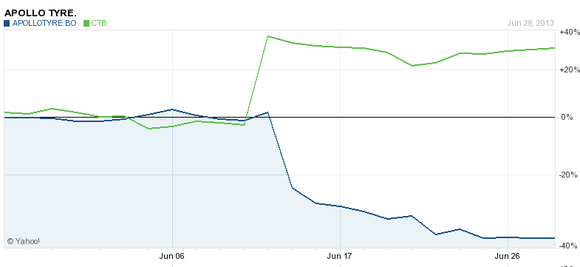That investors punished Apollo after the announced acquisition of Cooper Tire & Rubber Co (NYSE:CTB) for $2.5 billion in cash is not new in financial markets. In most acquisitions, the shareholders of the target firm walk away with great benefits and the markets punish the acquirer stating, ‘Did you pay too much?’
The graph below demonstrates the stock price movements of both the companies before and after announcement of the acquisition deal.

Does it make sense to acquire a company in a developed market, or should Apollo have tried acquiring a company in a fast growing market?

The combined entity will be uniquely positioned to leverage its well established brands – Cooper Tire & Rubber Co (NYSE:CTB), Apollo and Vredestein – and will have large market access through established markets, such as the USA and Europe, and emerging markets, such as India, China, Africa and Latin America. The acquisition will also allow targeting more segments – the passenger car, light and heavy truck and farm and highway vehicles.
The synergies could be in the form of operational or financial synergies. I believe that the following points illustrate, broadly, the synergies between Apollo and Cooper Tire & Rubber Co (NYSE:CTB).
Operating synergy:
- Economies of scale : The combined entity will have advantages in terms of cost-efficiency through raw material procurement
- Higher growth : The combined firm will be able to introduce products and brands in each other’s markets
- Functional strengths: The two companies bring their strengths in technology, R&D and other functional areas where there could be overlap
Financial synergy:
- Debt capacity: The combined firm will have more capacity to take debts. In this case, the holding company will issue bonds worth $2.1 billion, which would be serviced by Cooper Tire & Rubber Co (NYSE:CTB) and its European operations. The rest, $450 million, will be raised at its Mauritian subsidiary and will be serviced by the Indian operations
The book value of equity of Cooper = $815.9 M[1]
Market value of Cooper before acquisition = 63.34 M[2] * 24.56[3]= $1553.6 M
Acquisition price of Cooper = 63.34*35 = $2216.9 M
Premium paid for acquisition = $661.2 M
The management estimates that they will be able to generate savings in the range of $80 M-$120 M per year from the third year onward.
Assuming managements’ best estimate of $120 M in saving, we valued synergy, and it comes around $700.5 M[4]
It seems that the premium of $661.2 M paid was reasonable. Why did Investors punish Apollo then?
The answer lies not in the premium paid, but the way it is paid i.e. the huge debt burden that could strain the balance sheet of the combined entity
The competition
The North American operation is highly competitive and Cooper Tire & Rubber Co (NYSE:CTB) faces stiff competition from Bridgestone, The Goodyear Tire & Rubber Company (NASDAQ:GT) and Groupe Michelin. These competitors are substantially larger than Cooper Tire & Rubber Co (NYSE:CTB) and serve OEMs as well as replacement tire market. Apollo-Cooper will face the heat of the competition in both North American and Asian markets.
Michelin has already invested $1.5 billion to build a tire factory in Shenyang to focus on the high-end replacement tire segments of China’s tire market. With Asian growth in mind, Bridgestone has opened a new plant in India with the capacity to manufacture 10,000 passenger car tires per day by the end of 2013. The poor economic climate in Europe has also forced The Goodyear Tire & Rubber Company (NASDAQ:GT) to focus on North America, Middle East and Africa. The North American business is providing excellent returns to The Goodyear Tire & Rubber Company (NASDAQ:GT) and management expects to have positive cash flows in 2013 too.
The forward looking estimates:
| Growth Est | CTB | BRDCY | GT | Industry | Sector | S&P 500 |
|---|---|---|---|---|---|---|
| Next 5 years
( per annum) | 8.60% | 12.20% | 41.00% | 18.25% | 16.43% | 9.42% |
Based on the analyst’s estimates, The Goodyear Tire & Rubber Company (NASDAQ:GT) tires is supposed to have the maximum annual growth among its peers followed by Bridgestone, while Cooper lags behind with 8.6% annual growth, which is lower than that of industry or sector growth. It is evident that the challenges lie ahead for Cooper. However, the synergy in acquisition might push the growth rates in the coming years.
In sum, the acquisition of Cooper seems to be a strategic move for Apollo, and it has paid a reasonable premium to Cooper based on the synergies. However, in order to create sustainable competitive advantage, the management team of both Apollo and Cooper will have to leverage their capabilities, strength of their brands, strategic decisions and good marketing.
[1] Yahoo Finance : http://finance.yahoo.com/q/bs?s=CTB
[2] Outstanding shares = 63.34 M
[3] Share price on June 11th 2013 before the announcement of acquisition =24.56
[4] Value of Synergy = Value of Independent companies ( Apollo + cooper) – Value of combined firm with synergy ($120 M in saving per year from third year)
The article The Synergies in the Apollo-Cooper Deal originally appeared on Fool.com.
Saurabh Mishra has no position in any stocks mentioned. The Motley Fool has no position in any of the stocks mentioned. Saurabh is a member of The Motley Fool Blog Network — entries represent the personal opinion of the blogger and are not formally edited.
Copyright © 1995 – 2013 The Motley Fool, LLC. All rights reserved. The Motley Fool has a disclosure policy.





